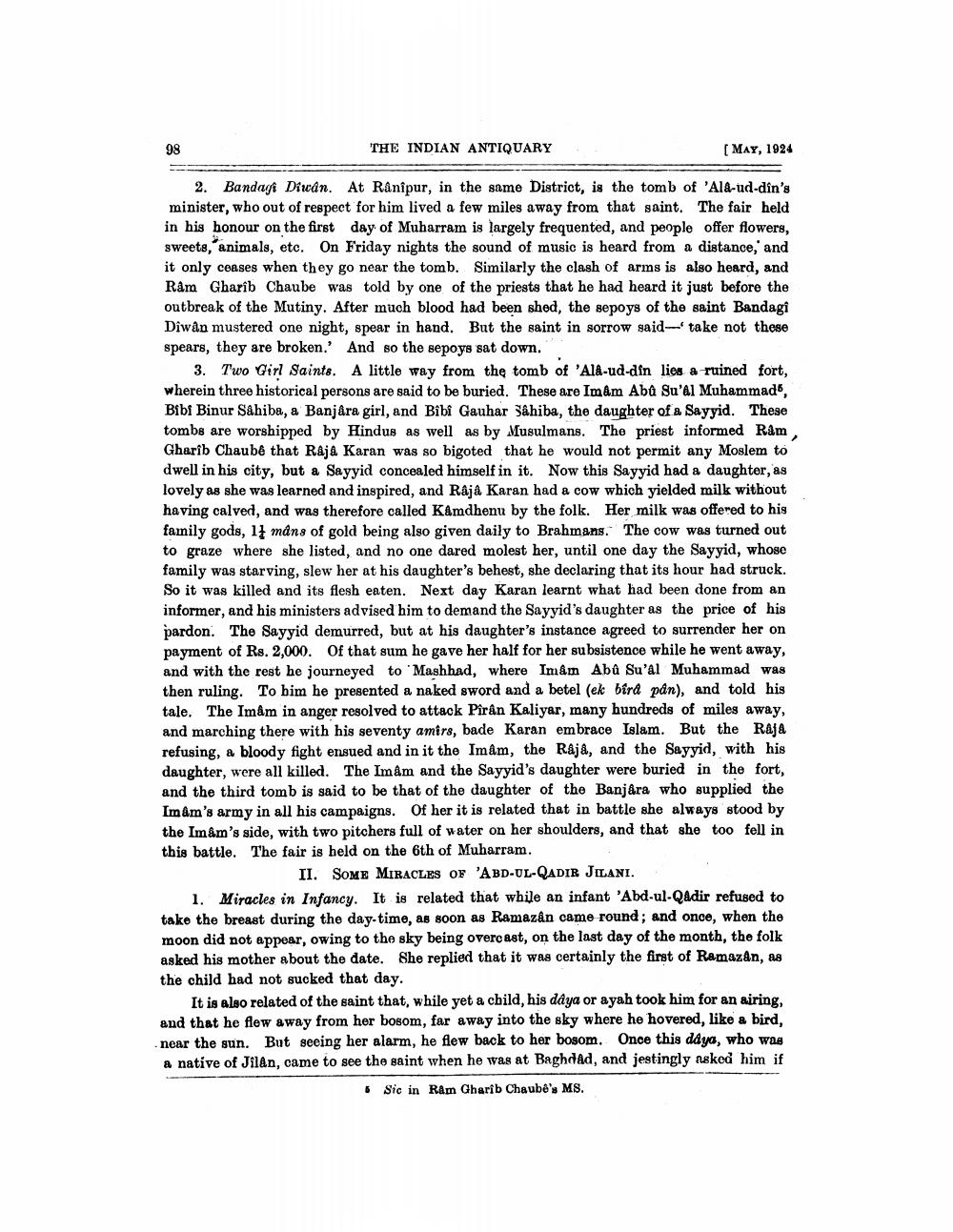________________
THE INDIAN ANTIQUARY
[MAY, 1924
2. Bandag Diwán. At Rånipur, in the same District, is the tomb of 'Ald-ud-din's minister, who out of respect for him lived a few miles away from that saint. The fair held in his honour on the first day of Muharram is largely frequented, and people offer flowers, sweets, animals, etc. On Friday nights the sound of music is heard from a distance, and it only ceases when they go near the tomb. Similarly the clash of arms is also heard, and Ram Gharib Chaube was told by one of the priests that he had heard it just before the outbreak of the Mutiny. After much blood had been shed, the sepoys of the saint Bandagi Dîwan mustered one night, spear in hand. But the saint in sorrow said-take not these spears, they are broken.' And so the sepoys sat down.
3. Two Girl Saints. A little way from the tomb of 'Ald-ud-din lies a ruined fort, wherein three historical persons are said to be buried. These are Imam Abu Su'al Muhammad, Bibi Binur Sahiba, a Banjára girl, and Bibi Gauhar Sahiba, the daughter of a Sayyid. These tombs are worshipped by Hindus as well as by Musulmans. The priest informed Ram Gharib Chaube that Raja Karan was so bigoted that he would not permit any Moslem to dwell in his city, but a Sayyid concealed himself in it. Now this Sayyid had a daughter, as lovely as she was learned and inspired, and Raja Karan had a cow which yielded milk without having calved, and was therefore called Kamdhenu by the folk. Her milk was offered to his family gods, 14 mans of gold being also given daily to Brahmans. The cow was turned out to graze where she listed, and no one dared molest her, until one day the Sayyid, whose family was starving, slew her at his daughter's behest, she declaring that its hour had struck. So it was killed and its flesh eaten. Next day Karan learnt what had been done from an informer, and his ministers advised him to demand the Sayyid's daughter as the price of his pardon. The Sayyid demurred, but at his daughter's instance agreed to surrender her on payment of Rs. 2,000. Of that sum he gave her half for her subsistence while he went away, and with the rest he journeyed to 'Mashhad, where Imam Abu Su'al Muhammad was then ruling. To bim he presented a naked sword and a betel (ek bîra pan), and told his tale. The Imam in anger resolved to attack Piran Kaliyar, many hundreds of miles away, and marching there with his seventy amirs, bade Karan embrace Islam. But the Raja refusing, a bloody fight ensued and in it the Imam, the Raja, and the Sayyid, with his daughter, were all killed. The Imam and the Sayyid's daughter were buried in the fort, and the third tomb is said to be that of the daughter of the Banjara who supplied the Imâm's army in all his campaigns. Of her it is related that in battle she always stood by the Im&m's side, with two pitchers full of water on her shoulders, and that she too fell in this battle. The fair is held on the 6th of Muharram.
II. SOME MIRACLES OF 'ABD-UL-QADIR JILANI. 1. Miracles in Infancy. It is related that while an infant 'Abd-ul-Qadir refused to take the breast during the day-time, as soon as Ramazan came round, and once, when the moon did not appear, owing to the sky being overcast, on the last day of the month, the folk asked his mother about the date. She replied that it was certainly the first of Ramazan, as the child had not sucked that day.
It is also related of the saint that, while yet a child, his daya or ayah took him for an airing, and that he flew away from her bosom, far away into the sky where he hovered, like a bird, near the sun. But seeing her alarm, he flew back to her bosom. Once this daya, who was a native of Jilan, came to see the saint when he was at Baghdad, and jestingly nskod him if
Sic in Ram Gharib Chaube's MS.




